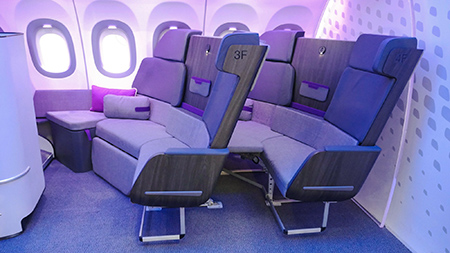Subscriber Benefit
As a subscriber you can listen to articles at work, in the car, or while you work out. Subscribe NowCommercial flying may have lost its mythical appeal from the bygone jet age but aerospace companies are nevertheless busy trying to improve the passenger experience on board an aircraft.
In the hyper-competitive world of aviation, more comfort in the cabin can be a major selling point for airlines, and cabin amenities (or the lack thereof) are oft-discussed features on social media platforms.
At the annual Aircraft Interiors Expo in Hamburg, the biggest showcase for innovation in the cabin, hundreds of exhibitors presented new seats, fabrics, lights, in-flight entertainment systems or creative layout concepts.
Here are some of the key trends and features presented at this year’s show in Hamburg by more than 500 exhibitors.
◗ Feel at home: Over the decades, seat and cabin fabrics have veered from psychedelic to muted tones. The latest trend is a more homey feeling. Lantal Textiles, an aircraft fabric manufacturer, showcased cabin curtains with a more plush, three-dimensional weave, and Lonseal Inc. presented flooring that mimics the grainy details of real wood for a more soothing atmosphere in the cabin space.
Mood lighting continues to be a major force of cabin innovation, but the new generation of LED lights also lets airlines considerably cut weight. Collins Aerospace introduced a reading lamp that can adapt to different applications, from large spot to small target, with full-color options, eliminating the need for additional elements such as sidewall lighting.
◗ Get comfortable (even in economy): Flat-bed seats in business and first class have been a feature for more than a decade, but the humble economy seat has remained largely built for purpose: slender, lightweight, limited comfort. Recaro Holding presented a redesign of its CL3710 back-of-the-cabin seat built especially for long-distance routes, which features additional sleeping aids such as wrap-around head support and a retractable ledge to extend the seat and provide more thigh support. Feeling too hot or cold in the cabin? Lantal is working on a temperature-control system that lets the occupant heat or cool their seat.
At the more luxurious spectrum of the cabin, Airbus is experimenting with a new seat layout that it calls the settee corner, combining a single-person seat with a bench design that can be used for meetings during flight or to spread out for a nap.
◗ Scent and sensibility: Feeling nauseous because there’s a stale smell wafting through the cabin? Panasonic Avionics Corp. is bringing an air-deodorizing system to the cabin that purifies the area around a (business) passenger’s seat, using nano-sized electrostatic atomized particles to neutralize air and battle viruses and bacteria. At the Hamburg show, engineers showcased the technology using a piece of cloth infused with the dubious odor of stale French fries. After about a minute of bursts from the nano-particle stream, the smell was of clean sheets.
Over at Fokker Technologies, engineers are working on infusing the cabin with distinct fragrances. The company is collaborating with cosmetics brand Rituals on a product that distributes scents through the air-conditioning system, promising greater passenger comfort or the ability to create signature airline scents for better brand recognition.
◗ Mapping it out: While in-flight entertainment has come a long way since movies were projected onto a screen, there’s still a long road ahead to turn the media offerings into a dedicated, personal experience. In-flight maps remain one of the most popular features in the cabin, but the experience lags the immersive features that have become prevalent on mobile devices. Panasonic has created a map that uses travel information from a passenger’s loyalty-program profile and integrates it with in-flight entertainment features. Coming to airlines next year, the map will allow passengers to use FlightAware data that follows flight paths of other aircraft.
◗ Smart bins: Few things are more tedious than standing at the luggage carousel after a long journey, which is why more people try to cram their suitcases into the overhead compartments. Airbus and Boeing have both been working on bigger bins, and Boeing showcased the new layout of its 777X wide-body aircraft. At some point in the future, Airbus wants to give passengers the option to book their own bin space, helping overcome bruising battles in the cabin between passengers for storage space.•
Please enable JavaScript to view this content.

